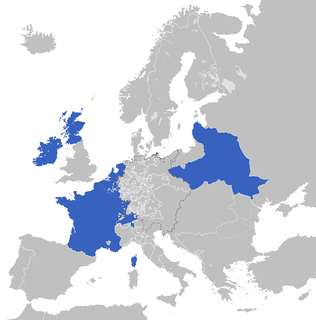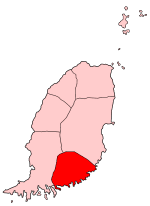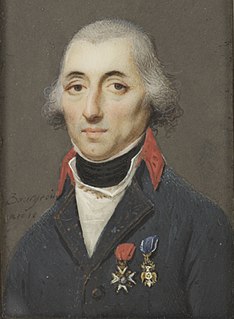The history of islands of Grenada in the Caribbean, part of the Lesser Antilles group of islands, covers a period from the earliest human settlements though to the establishment of the contemporary nationstate of Grenada.

This article is about the demographic features of the population of Grenada, including population density, ethnicity, education level, health of the populace, economic status, religious affiliations and other aspects of the population.

Whit Monday or Pentecost Monday, also known as Monday of the Holy Spirit, is the holiday celebrated the day after Pentecost, a moveable feast in the Christian calendar. It is moveable because it is determined by the date of Easter. In the Catholic Church, it is the Memorial of the Blessed Virgin Mary, Mother of the Church, marking the resumption of Ordinary Time.

Catherine-Dominique de Pérignon, 1st Marquis of Grenade was a Marshal of the Empire.

The Atlantic Revolutions were a revolutionary wave in the late eighteenth and early nineteenth centuries. It was associated with the Atlantic World during the era from the 1760s to the 1870s.

Saint Andrew's is the largest parish in Grenada. The main town is Grenville, which is also Grenada's second largest town after St George's. Grenville is also known as La Baye.

Saint David's Parish is the fourth largest of the parishes of Grenada in the island's southeast. The parish's main town is St. David's, located between La Tante and Westerhall. Because St David's is so small, the parish is sometimes referred to as "The Virgin Parish".

Grenville is the second largest town in Grenada, after St. George's, and it is the capital of the largest parish, Saint Andrew Parish. Grenville is located on Grenville Bay, about halfway up the east coast of the Caribbean island of Grenada and is heavily involved in the agriculture export industry. Grenville's Anglican Church and school stand at the north end of Victoria Street, the main thoroughfare along the bay.

Sauteurs is a fishing town in the Saint Patrick Parish, Grenada and is the fourth largest city on the island of Grenada, with a population of about 1,300. It is located in the far north of Grenada. Sauteurs is overlooking over the Sauteurs Bay. It is the largest town in the northern part of Grenada and it is the capital city of the Saint Patrick Parish.

Grenada is an island country in the West Indies in the Caribbean Sea at the southern end of the Grenadines island chain. Grenada consists of the island of Grenada itself, two smaller islands, Carriacou and Petite Martinique, and several small islands which lie to the north of the main island and are a part of the Grenadines. It is located northwest of Trinidad and Tobago, northeast of Venezuela and southwest of Saint Vincent and the Grenadines. Its size is 348.5 square kilometres (134.6 sq mi), and it had an estimated population of 112,523 in July 2020. Its capital is St. George's. Grenada is also known as the "Island of Spice" due to its production of nutmeg and mace crops.
Afro-Grenadians are Grenadian people of largely African descent. This term is not generally recognised by Grenadians or indeed Caribbeans. They usually refer to themselves simply as Black or possibly Black Caribbean. The term was first coined by an African Americans history professor, John Henrik Clarke (1915–1998), in his piece entitled A Note on Racism in History. The term may also refer to a Grenadian of African ancestry. Social interpretations of race are mutable rather than deterministic and neither physical appearance nor ancestry are used straightforwardly to determine whether a person is considered a Black Grenadian. According to the 2012 Census, 82% of Grenada's population is Black, 13% is mixed European and black and 2% is of Indian origin.

The Capture of Grenada was an amphibious expedition in July 1779 during the American Revolutionary War. Charles Hector, comte D'Estaing led French forces against the British-held West Indies island of Grenada. The French forces landed on 2 July and the assault occurred on the night of 3–4 July. The French forces assaulted the British fortifications on Hospital Hill, overlooking the island's capital, Saint George's. The British cannons were captured and turned against Fort George. British Governor Lord Macartney opened negotiations to surrender.

Jean Gaspard de Vence was a French privateer, admiral and Maritime Prefect of Toulon.
Fédon's rebellion was an uprising against British rule in Grenada. Although a significant number of slaves were involved, they fought on both sides. Predominantly led by free mixed-race French-speakers, the stated purpose was to create a black republic as had already occurred in neighbouring Haiti rather than to free slaves, so it is not properly called a slave rebellion, although freedom of the slaves would have been a consequence of its success. Under the leadership of Julien Fédon, owner of a plantation in the mountainous interior of the island, and encouraged by French Revolutionary leaders on Guadeloupe, the rebels seized control of most of the island, but were eventually defeated by a military expedition led by General Ralph Abercromby.
Julien Fédon, also called Julien Fedon, Foedonn, Feydn, and Fidon, was the leader of the Fédon Rebellion, a revolt against British rule led primarily by free mixed-race French-speakers that took place in Grenada between 2 March 1795 and 19 June 1796.
The French corvette Républicaine was a merchant ship launched in 1793 that the French Navy requisitioned in 1795 at Grenada. On 14 October 1795 Mermaid captured her in the Leeward Islands. The Royal Navy took Republicaine into service as HMS Republican, a lugger of 18 guns. It is not clear that Republican was ever commissioned. The Navy sold her at Grenada in 1803.
Marie Rose Cavelan was a French-Afro-Grenadian or possibly French-Amerindian-African-Grenadian planter and revolutionary. A free woman of color, she married Julien Fédon, a French Catholic, like herself of mixed ancestry. Together, she and her husband bought a plantation and engaged as planters and slave owners in the colonial period. Grenada changed hands between the French and British several times during the couple's life, causing persecution for the couple when the British were in authority. Cavelan was arrested in 1787 and forced to provide evidence of her free status, though she was well known to the British, having conducted numerous business transactions with British business men. Though large landowners, Cavelan and her husband were increasingly denied the right to engage in public affairs. In the 1790s they began manumitting their slaves and in 1795 staged a revolt against British rule. Branded traitors, they led a revolt which lasted nearly two years, but were never captured by the British. Cavelan's whereabouts after the rebellion ended are unknown.
Old Dick was launched at Bermuda in 1789. She sailed to England and was lengthened n 1792. From 1792 on she made two full voyages as a Liverpool-based slave ship. On her second she recaptured two British merchant ships. She was lost in 1796 at Jamaica after having landed her third cargo of slaves.












